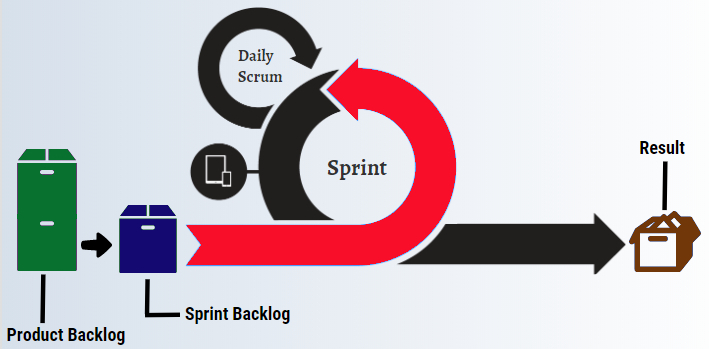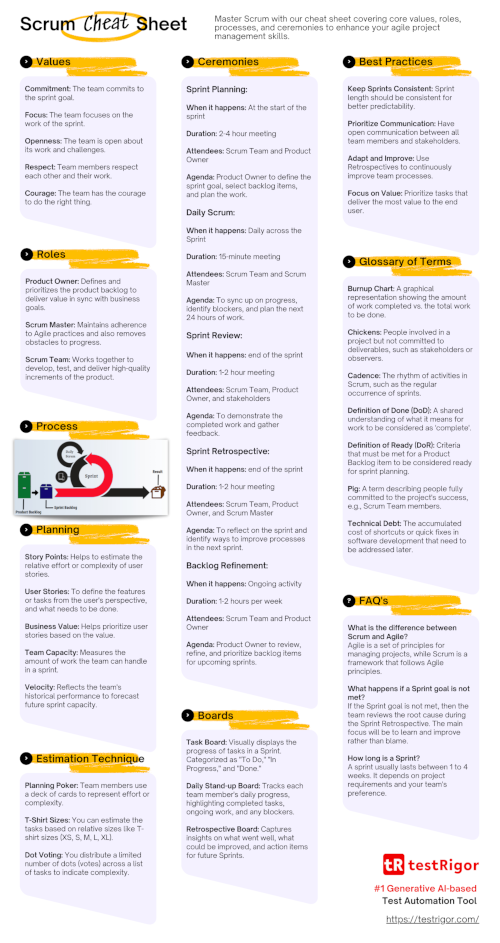Scrum Cheat Sheet
|
|


|
Copy and paste the code above to easily embed the Scrum Cheat Sheet image on your website.
|
Scrum Cheat Sheet Details
Let us have a look at these points in some detail:
Core Values in Scrum
- Commitment: The team pledges to achieve the goals set for the Sprint. They commit to dedicate their effort and to deliver value to stakeholders and end-users.
- Focus: The team concentrates on the prioritized work in the Sprint, avoiding distractions to maximize productivity.
- Openness: The team transparently shares progress, challenges, and decisions, to have trust and collaboration.
- Respect: As a team you should honor each other’s contributions, skills, and perspectives, to create a supportive working environment.
- Courage: The team boldly makes decisions, addresses challenges, and advocates for what is right, even when it might get difficult.
What are the Roles in Scrum?
-
Product Owner
- Visionary: Defines and communicates product vision and ensures that aligns with business goals.
- Backlog Manager: Creates, prioritizes, and maintains the product backlog.
- Stakeholder Liaison: Primary point of contact between stakeholders and the development team.
- Decision Maker: Makes key decisions on scope, priorities, and requirements
- Acceptance Criteria Setter: Defines acceptance criteria for the work items. They are responsible for accepting or rejecting the completed work.
-
Scrum Master
- Facilitator: Engages and arranges the scrum ceremonies like daily stand-ups, sprint planning, and sprint reviews. They make sure that these ceremonies are running smoothly and are time-efficient.
- Servant Leader: Serves the Scrum Team by removing any blockers that affect the project progress
- Coach and Mentor: Coaches the team about agile practices and also improves the team’s efficiency
- Shield for the Team: Protects the team from external distractions so that they can focus on their work.
- Change Agent: Brings continuous improvement within the team and organization by promoting agile values.
-
Scrum Team
- Self-Organizing: The team organizes and manages their own work without external direction.
- Cross-functional: Consists of diverse skills and expertise necessary to deliver a complete product increment.
- Collaborative: Works closely together, sharing knowledge and supporting each other to achieve common goals.
- Commitment to Sprint Goals: Commits to achieving the goals set for each sprint
- Continuous Improvement: Regularly reflects on their processes and performance during retrospectives.
How Scrum Works?
- Backlog Refinement: The Product Owner works with the team to refine the Product Backlog. Together they break down large items into smaller, more manageable tasks.
- Sprint Planning: As a team you select the highest-priority items from the Product Backlog to work on during the upcoming sprint. These items become the Sprint Backlog.
- Execution: Your development team works on the items in the Sprint Backlog, and aim to complete them by the end of the sprint. The Scrum Master helps remove obstacles, and the Product Owner is available to clarify requirements.
- Daily Scrum: As a team you meet daily for 15 minutes to discuss progress, identify any roadblocks, and adjust plans as needed.
- Sprint Review: At the end of the sprint, as a team, you can show the completed work to stakeholders, gathers feedback, and discusses the next steps.
- Sprint Retrospective: The team reflects on the sprint, discussing what went well, what didn’t, and how to improve in the next sprint.
- Repeat: Then repeat the same process with the next sprint, continuously delivering increments of value.
How to do Planning in Scrum?
- Story Points: Used to estimate the relative effort or complexity of user stories.
- User Stories: Define the features or tasks from the user’s perspective, guiding what work needs to be done.
- Business Value: Helps prioritize user stories based on the value they bring to the business or end users.
- Team Capacity: Measures the amount of work the team can handle in a sprint, helping in sprint planning.
- Velocity: It reflects your team’s historical performance. Which is then used to forecast future sprint capacity and planning.
Scrum Estimation Techniques
- Planning Poker: Team members use a deck of cards with values representing effort or complexity. After discussing a task, each member privately selects a card and the common value is considered as the task effort.
- T-Shirt Sizes: You can estimate the tasks based on relative sizes like T-shirt sizes (XS, S, M, L, XL). Tasks are categorized by their perceived effort without assigning exact numbers.
- Dot Voting: As a team, you can distribute a limited number of dots (votes) across a list of tasks to indicate their perception of complexity or priority
Ceremonies in Scrum
- Sprint Planning: This meeting occurs at the start of each Sprint, lasting 2-4 hours, with the Scrum Team and Product Owner in attendance. You have an agenda which includes defining the Sprint Goal, selecting Product Backlog items, and planning how the work will be executed.
- Daily Scrum: As a Scrum Team you attend a 15-minute daily meeting throughout the Sprint, with the Scrum Master. It helps to sync up on progress, identify any blockers, and plan the work for the next 24 hours.
- Sprint Review: It is done at the end of the Sprint. This 1-2 hour meeting involves the Scrum Team, Product Owner, and other stakeholders. The team shows the work completed during the Sprint and gathers feedback to improve future work.
- Sprint Retrospective: It is done at the end of the Sprint. This 1-2 hour meeting includes the Scrum Team, Product Owner, and Scrum Master. The focus is to reflect on the Sprint and identify process improvements for the next Sprint.
- Backlog Refinement: An ongoing activity typically lasting 1-2 hours per week. It involves the Scrum Team and Product Owner. The purpose is to review, refine, and prioritize Product Backlog items and then prepare for upcoming Sprints.
Artifacts in Scrum
- Product Backlog: Maintained by Product Owner. It is the prioritized list of all features, enhancements, bug fixes and technical work that might be needed in the product.
- Sprint Backlog: This is a set of Product Backlog items selected to be delivered for the current sprint. This is created and managed by the Scrum Team during Sprint planning.
- Increment: The sum of all Product Backlog items completed during a sprint, along with the value of the increments from all previous sprints
- Burndown Chart: A graphical tool that displays the remaining work versus time. You can use it to track your team’s progress toward completing the sprint goal.
- Release Backlog: A prioritized subset of the Product Backlog, which focuses on the items to be delivered in a specific release. The Release Backlog is broader and focuses on a set of sprints. On the other hand, the Sprint Backlog is narrower and focused on just one sprint.
What are Boards in Scrum?
- Task Board: It is used to track the progress of tasks throughout the sprint. Columns typically represent stages of work (e.g., To Do, In Progress, Done). These tasks move across the board as they are worked on.
- Daily Stand-up Board: You can use it during the Daily Scrum to quickly review the progress and update the team on what was done yesterday, what will be done today, and any blockers.
- Retrospective Board: Team uses it during Sprint Retrospectives to capture what went well, what didn’t. Also, you decide on what improvements can be made for the next sprint.
Scrum Best Practices
- Keep Sprints Consistent: You should maintain a consistent Sprint length so that your team predicts work capacity and plans more effectively.
- Prioritize Communication: Have an open communication among team members and stakeholders to make sure these is alignment and swift issue resolution.
- Adapt and Improve: Retrospectives allows you to reflect on the process and make iterative improvements.
- Focus on Value: Prioritize tasks that deliver the highest value so that your team’s efforts are perfectly aligned with business and user needs.
Additional Resources
- Test Automation in Scrum: How to do it Effectively?
- Scrum vs. Kanban vs. Lean
- A Roadmap to Better Agile Testing
Conclusion
“It doesn’t matter how good you are today; if you’re not better next month, you’re no longer agile. You must always, always, always try to improve” – Mike Cohn.
As we understand, Scrum is an adaptive framework that helps you to manage complex projects efficiently through its structured, iterative process. It solely focuses on collaboration, transparency, and continuous improvement. It makes sure that teams can respond to changes quickly, deliver high-quality increments consistently, and refine their processes with each sprint.
The defined roles, events, and artifacts within Scrum create a clear roadmap for achieving project goals. Therefore, it is an effective methodology not just in software development but in a variety of fields that require agile and responsive project management.
| Achieve More Than 90% Test Automation | |
| Step by Step Walkthroughs and Help | |
| 14 Day Free Trial, Cancel Anytime |












